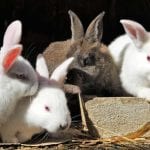Rabbits are best known for their efficient and fast breeding in the wild. Knowing the fact that these creatures are prey animals, they need to have plenty of offspring to ensure that their species endure the challenge of predation. Nevertheless, breeding rabbits may require so much work and may not suit everybody’s skills and capability.
If you intend to breed rabbits either for food or trying to procreate a specialize breed, then you must get a good pair for breeding. You have to condition yourself and be willing to accept once the attempt becomes successful or a failure. You should always comprehend how much work awaits ahead of you.
When is the Best Time to Breed?
Rabbits can be bred depending on their age and size. Rabbits do not have a regular cycle of ovulation. As an outcome, they do not come into heat. The act of mating between rabbits will lead the female rabbit to produce the eggs needed for fertilization, normally 10 to 13 hours after breeding took place.
Even though the female rabbit develops no actual heat cycle, the female rabbit will only take the male rabbit in roughly 12 out of the 14 days. Once the female rabbit is set to breed, you will notice her vent portion to be purple, red, or dark pink.
Should you Breed Rabbit Siblings?
Many are used to breeding rabbits, but have any of you have tried breeding rabbit siblings? Is it possible to breed rabbit siblings? If so, would you consider doing that? How do you understand about breeding rabbit siblings? Some people may have the initial thinking that inbreeding among rabbits is not right.
But the truth is – inbreeding is not necessarily destructive. It can be good at some point. You can find several reasons why inbreeding can also be helpful.
Mating related rabbits are called inbreeding. It is a process of breeding a rabbit with a much more closely connection, commonly a brother or a sister. Very rare has been attempting this kind of breeding due to some considerations; however, this does not imply that you cannot do it.
Almost animals were subjected to inbreeding, and rabbits make no exception to this. Each breed of a domesticated rabbit has been bred by people into how they are developed now.
Understanding the Process of Inbreeding
Inbreeding among rabbits is the process of breeding related rabbits. Breeding rabbit siblings is a rare case; however, it is feasible. Breeding such intimately related animals can hugely improve its characteristics, both good and bad. Inbreeding is an ideal method to incite the features and traits of the ancestor and dam; however, it may also produce bad rabbits that should be plucked due to deformities, temperament, or health.
When you breed rabbit siblings, you must cull massively and only retain what you are very pleased with. There is nothing to worry about since you are not going to produce a two-headed Franken rabbit because you did the inbreeding; however, you should be cautious that receding genes both good and bad will be improved.
Why Inbreed Rabbits?
If you intend to restrict the length of genes in your rabbits by that improving the good and bad characteristics and can assort and cull out the inadequate outputs regularly and carrying on to the following generation, then you can improve the stock of your breeding to your unique liking.
Even so, if you have a keen eye and a reasonable judgment, you can come up with an excellent stock of rabbit. If you are trying to figure out how to acquire the best flock with the minimal quantity of animals, then you must surely consider how closely connected you like your rabbits to be through the long yield. If you begin with an ideal stock and have a nice flock and perform selective breeding, the process of inbreeding will establish strength – not weakness.
The more related the rabbits, the higher the tendency that the two unfavorable genes for a characteristic, becomes present passively in both siblings, shall complement and be incapable of inhibiting a seemingly negative or deteriorated offspring.
A pairing of passives is what commonly lead to albinism and other various recessive characteristics such as the size and the color. There should be no issue there. However, it can be very unpleasant if that poor result is metabolic or structural, such as buck teeth, polycystic kidneys, cataracts, or inclination to cancer.
The process of inbreeding does not directly bring these problems – rather, it is the pairing of pre-existing genetic falls that forms the problems.
What are the risks?
Naturally, breeding rabbit siblings can lead to some very harmful results to individuals. It may deteriorate agility, which is the same as the general health of the species. Resistance to disease, fertility, and body weight can all be jeopardized brought by the impacts made by the inbreeding.
Similar results can be uttered for inbred rabbits, too, right? There is a reality with the information that highly inbred rabbits may develop misshaped parts or malformations. A lot of these malformations are fatal, and the baby rabbits shall either be born dead or die immediately after being delivered.
Malformations commonly happen among highly inbred rabbits. Malformations start to develop most normally in the much subsequent generations, typically around the tenth or eleventh full-sibling mating. They may extend from cervical fusion, an undeveloped or very delicate skull, or deformations and scoliosis of the ribs.
Furthermore, genetic concerns may also come up much more often. The simplest illustration to look at is overgrown teeth or malocclusion because this problem can post great danger to the health of the rabbit if not treated regularly, it will not slay the baby rabbits before they become mature.
More genetic concerns may occur; however, most of the time, inbred kits are minimal in quantity and fail to survive due to other causes before genetic problems can occur. Intensive inbreeding may also affect the rate of fertility.
Inbreeding may also lead to developmental interruption, greater infant fatality, a shorter year to live, and deterioration of the ability of the immune system. The immune system of the rabbit is nearly associated with the elimination of cancer cells from a vigorous body; thus, the deterioration of the functionality of the immune system heightens the danger of tumor formation. The immune system is also crucial as it works to defend the animal against contagious diseases.
What are the Benefits?
To make sure that you will be getting the best results of breeding rabbit siblings, you should secure a great foundation stock. Inbreeding can help to convene in on and boost positive traits and characteristics. The process of inbreeding will help you get rid of the genetic disparities in offspring, so inbred rabbits become more coordinated. This is remarkable if the baby rabbits you are generating do an impressive job on the show table!
A fascinating result which inbreeding can trigger is receding genes to occur. Although a number of these genes are not favorable, basic recessive genes such as the color may also occur and develops no impact on the general health of the rabbit.
Things to Remember when Breeding
Breeding rabbit siblings is an acceptable process. However, there should be corresponding risks in doing this method. Use only healthy rabbits. Inspect the rabbits for any vent diseases before proceeding to breed. See to it that the general condition of the rabbit is healthy. Check the cages for any signs of loose droppings.
If you think that any of the rabbits is sick or suffering from an illness, you have to wait until the rabbit has fully recovered from the illness. Avoid choosing rabbits with genetic issues. Certain rabbits will often forward those genetic issues to their offspring.
Final Thoughts
Choosing suitable rabbits is one of the essential factors for an effective breeding program. In addition to choosing pairs to mate according to strengths and complementary faults, consider choosing rabbits in the same ancestors. Until you can produce calculable outputs, there will always be a huge possible component of any kind of breeding that you will do.
You like to confine the length of genes, evaluate the unpleasant outputs, gather the favorable results, and keep on going with your program until you produce more calculable results. The moment you establish your line, you may regularly assess the faults that you develop. Then you may like to begin in a different line that exhibits strength in that particular area.
Unless you equip yourself with enough knowledge about breeding rabbit siblings, try to consider breeding pairs that are not closely connected. Again, breeding rabbit siblings is doable, but there is a lot of considerations when doing this. You need to carefully assess whether the benefits that you will get from this method can compensate for the risks and dangers that it can impose on the baby rabbits. Getting a full understanding of the genetics of breeding rabbit siblings will help you in finalizing your decision.

